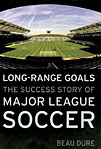 The Success Story of Major League Soccer
The Success Story of Major League Soccer
by Beau Dure
Potomac, £22.00
Reviewed by David Wangerin
From WSC 285 November 2010
It may not be saying that much, but Major League Soccer – now approaching the end of its 15th season – is the longest running coast-to-coast soccer league North America has ever had. And, as Beau Dure writes at the end of this book: "Whether MLS has ‘arrived' is a moot point. It's here. And it's healthy."
Health, of course, is relative. MLS may have grown to 16 teams, secured a presence on national television and put David Beckham on its payroll, but its major-league pretensions continue to be dismissed by many. Indeed, what has actually kept the league going isn't so much 22 men chasing a piece of synthetic leather as a level of financial enterprise the rest of the world has never needed to call on, or at least not been able to.
Among other things, the circuit's wealthy benefactors have facilitated the construction of several soccer-specific stadiums. More curiously, they also splashed out on broadcasting rights to the World Cup – a money-spinner without which, according to its commissioner, MLS "would not be in existence today".
Long-Range Goals is certainly not an assessment of the league's business model – and given the stupefying complexities of how MLS populates its squads (among other things) that's probably no bad thing. At the same time, though, those looking for a season-by-season recitation of events surely have all they could possibly need online – and yet it's this that forms most of Dure's narrative. When he breaks away long enough from recapping to address specific themes – like the two other proposals that rivalled MLS's initial bid, the players' early legal challenge to the league's single-entity structure or the "phenomenon" of Freddy Adu (remember him?) – things become more compelling. There's no doubting Dure's acquaintance with the subject – he writes about it for USA Today – but across the chapters he often leaves it to his interviewees to provide the necessary interpretation.
Not that there's anything wrong with what's here – much like MLS itself, in a way. But making a gripping read out of the steady and unspectacular progress of a sports enterprise not yet out of short trousers is a daunting proposition, and one that cries out for plenty of context. Dure does touch some of the more noteworthy motifs – the burgeoning popularity of the World Cup, the short-lived women's pro league and the rise of an American fan culture. But it's only in the last chapter – in the section headed "The Agenda", where he identifies the major challenges for the years ahead – that he provides a sustained level of argument. Not surprisingly, it's the most engaging part of the book.
Whether MLS has "arrived" is indeed moot. Perhaps the real question is whether it deserves greater respect. A book about it is certainly a step in that direction.